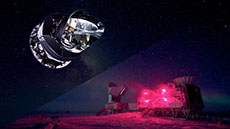Cosmic inflation remains undiscovered
 |
| A new study puts earlier discovery claims by the BICEP2 collaboration into perspective. Image: Andy Freeberg, SLAC |
A previous study claiming the discovery of gravitational waves as cosmic inflation’s fingerprint has most likely been over-interpreted, scientists found in a joint analysis between the Planck and BICEP2 experiments.
The new study, whose key results were released today in statements from the European Space Agency and the National Science Foundation, did not find conclusive evidence of cosmic inflation. Cosmic inflation is the exponential growth of the universe within the first few fractions of a second after the big bang almost 14 billion years ago.
“This joint work has shown that [the earlier claims are] no longer robust once the emission from galactic dust is removed,” says Jean-Loup Puget, principal investigator of Planck’s High Frequency Instrument at the Institut d’Astrophysique Spatiale in Orsay, France, in the statements. “So, unfortunately, we have not been able to confirm that the signal is an imprint of cosmic inflation.”
“These results have important consequences for the entire research field,” says Planck project scientist Jan Tauber from ESA. “They will impact how future experiments searching for cosmic inflation will be designed.”
Controversial cosmic pattern
In the 1980s, physicists Alan Guth and Andrei Linde developed the theory of cosmic inflation. This rapid expansion would have left its mark in the form of a pattern in the cosmic microwave background — faint light left behind from just after the big bang. The BICEP2 experiment was designed to search for this pattern.
Last March, BICEP2 scientists announced that they had found the characteristic pattern, and that it was even more pronounced than expected. If this interpretation turned out to be confirmed, it would be direct evidence of cosmic inflation.
However, scientists began to raise the concern that the pattern found by the BICEP2 study could have been caused by something else, such as dust in our own galaxy.
The BICEP2 researchers were aware that dust might give them a false signal. To minimize this possibility, they located their experiment at the South Pole and pointed their telescope at a part of the sky that was considered particularly “clean.” Then, in their analysis, the researchers carefully subtracted possible dust signals based on various theoretical models and earlier dust measurements.
Read more
—Manuel Gnida
|